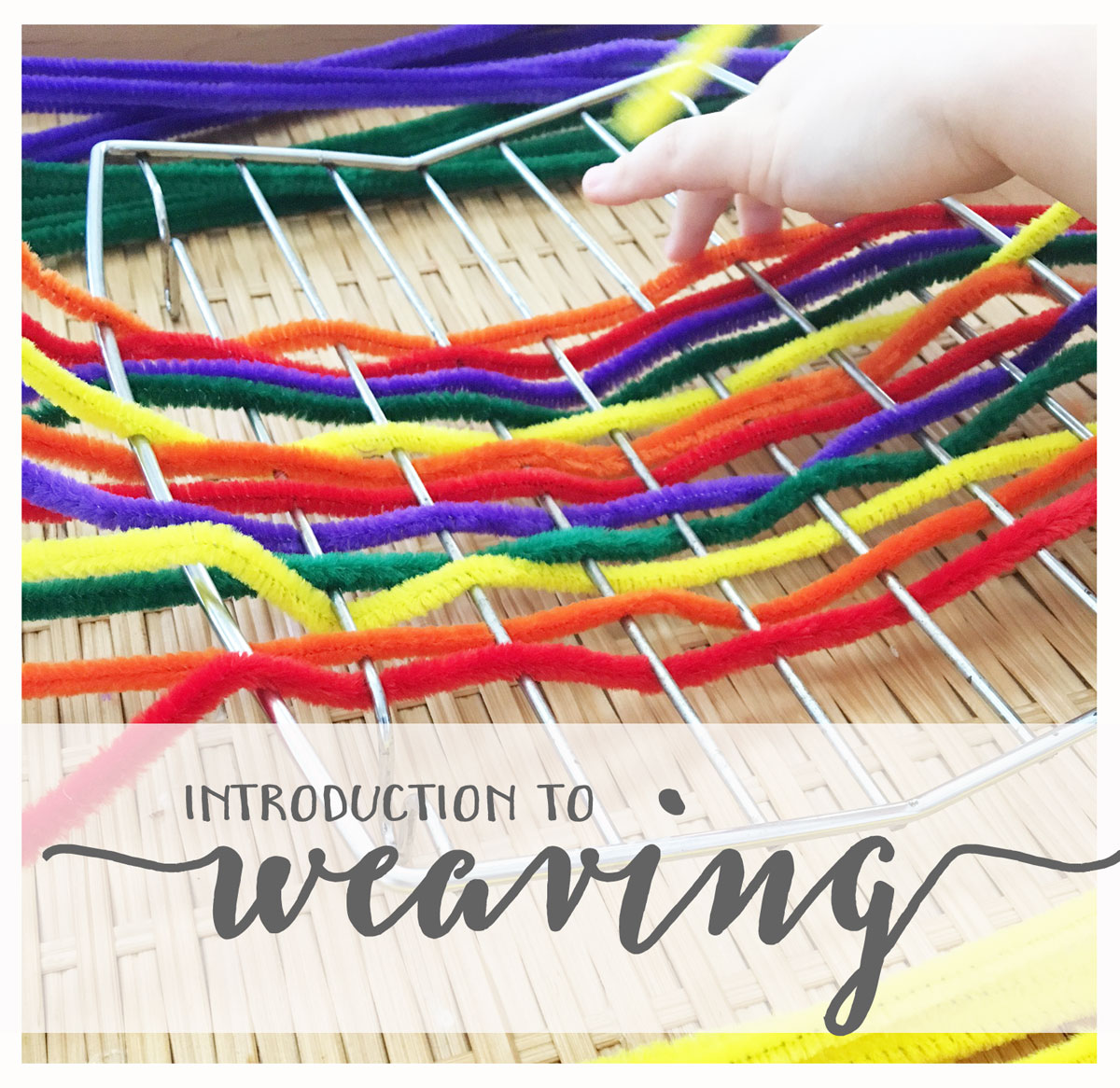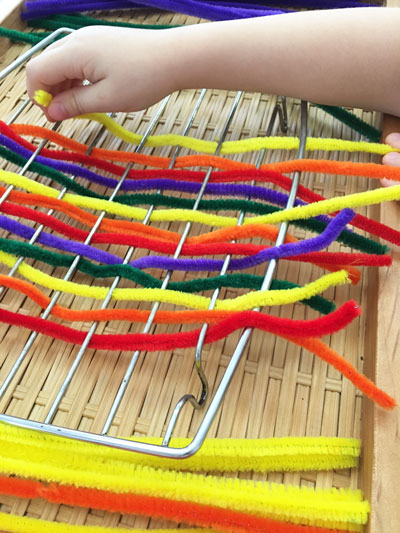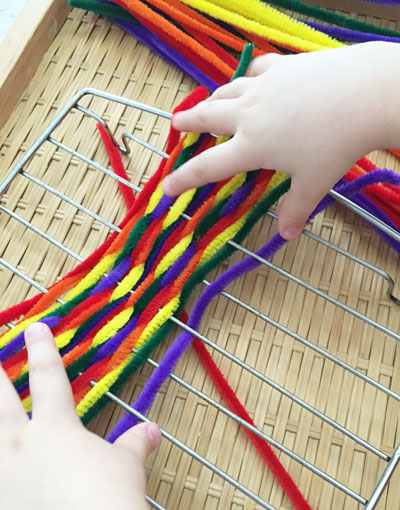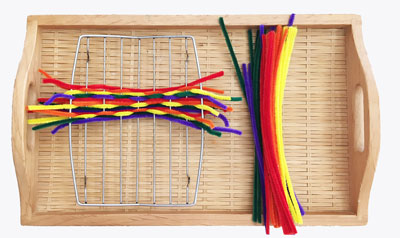Introduction to Weaving

What you'll need:
Pipe cleaners or Ribbon
Wire baking or organization rack
Getting Started:
Weaving is a wonderful exercise for preschool children, as it teaches concentration and reinforces fine motor skills (particularly between the thumb and forefinger) that support their pre-writing skills.
Weaving also helps to develop hand-eye coordination, and a sense of direction (up, down, over, under, top, bottom, right, and left) as children to use the visual information received to coordinate the movement of the hands.
This activity also presents an opportunity to talk about how clothing, baskets, and other woven items are made. Explore your home together and identify woven items, or objects that could act as a loom, such as a baby gate or railing.
To begin:
• Locate a wire baking/cooling rack, or an organizational rack.
• Collect pipe cleaners, string, or spare ribbon to use as your weaving materials. Note: Larger, easier to grasp, materials will be easier for young children and help prevent frustration.
• Take time to first demonstrate threading the material over and under the rack wires, and/or alternate turns with your child until they fully grasp the activity
• Encourage them to be creative, making patterns with the materials
• Push the rows together to demonstrate how the loom works and fabrics are created
This activity is meant to be an introduction to weaving; however as children become more proficient, they can move on to a circle or threaded loom to complete finished woven materials.
What it teaches:
Fine Motor Skills
Hand-Eye Coordination
Focus & Concentration
Direction & Tracking
Creativityn


What you'll need:
Pipe cleaners or Ribbon
Wire baking or organization rack
Getting Started:
Weaving is a wonderful exercise for preschool children, as it teaches concentration and reinforces fine motor skills (particularly between the thumb and forefinger) that support their pre-writing skills.
Weaving also helps to develop hand-eye coordination, and a sense of direction (up, down, over, under, top, bottom, right, and left) as children to use the visual information received to coordinate the movement of the hands.
This activity also presents an opportunity to talk about how clothing, baskets, and other woven items are made. Explore your home together and identify woven items, or objects that could act as a loom, such as a baby gate or railing.
To begin:
• Locate a wire baking/cooling rack, or an organizational rack.
• Collect pipe cleaners, string, or spare ribbon to use as your weaving materials. Note: Larger, easier to grasp, materials will be easier for young children and help prevent frustration.
• Take time to first demonstrate threading the material over and under the rack wires, and/or alternate turns with your child until they fully grasp the activity
• Encourage them to be creative, making patterns with the materials
• Push the rows together to demonstrate how the loom works and fabrics are created
This activity is meant to be an introduction to weaving; however as children become more proficient, they can move on to a circle or threaded loom to complete finished woven materials.
What it teaches:
Fine Motor Skills
Hand-Eye Coordination
Focus & Concentration
Direction & Tracking
Creativityn


What you'll need:
Pipe cleaners or Ribbon
Wire baking or organization rack
Getting Started:
Weaving is a wonderful exercise for preschool children, as it teaches concentration and reinforces fine motor skills (particularly between the thumb and forefinger) that support their pre-writing skills.
Weaving also helps to develop hand-eye coordination, and a sense of direction (up, down, over, under, top, bottom, right, and left) as children to use the visual information received to coordinate the movement of the hands.
This activity also presents an opportunity to talk about how clothing, baskets, and other woven items are made. Explore your home together and identify woven items, or objects that could act as a loom, such as a baby gate or railing.
To begin:
• Locate a wire baking/cooling rack, or an organizational rack.
• Collect pipe cleaners, string, or spare ribbon to use as your weaving materials. Note: Larger, easier to grasp, materials will be easier for young children and help prevent frustration.
• Take time to first demonstrate threading the material over and under the rack wires, and/or alternate turns with your child until they fully grasp the activity
• Encourage them to be creative, making patterns with the materials
• Push the rows together to demonstrate how the loom works and fabrics are created
This activity is meant to be an introduction to weaving; however as children become more proficient, they can move on to a circle or threaded loom to complete finished woven materials.
What it teaches:
Fine Motor Skills
Hand-Eye Coordination
Focus & Concentration
Direction & Tracking
Creativityn


What you'll need:
Pipe cleaners or Ribbon
Wire baking or organization rack
Getting Started:
Weaving is a wonderful exercise for preschool children, as it teaches concentration and reinforces fine motor skills (particularly between the thumb and forefinger) that support their pre-writing skills.
Weaving also helps to develop hand-eye coordination, and a sense of direction (up, down, over, under, top, bottom, right, and left) as children to use the visual information received to coordinate the movement of the hands.
This activity also presents an opportunity to talk about how clothing, baskets, and other woven items are made. Explore your home together and identify woven items, or objects that could act as a loom, such as a baby gate or railing.
To begin:
• Locate a wire baking/cooling rack, or an organizational rack.
• Collect pipe cleaners, string, or spare ribbon to use as your weaving materials. Note: Larger, easier to grasp, materials will be easier for young children and help prevent frustration.
• Take time to first demonstrate threading the material over and under the rack wires, and/or alternate turns with your child until they fully grasp the activity
• Encourage them to be creative, making patterns with the materials
• Push the rows together to demonstrate how the loom works and fabrics are created
This activity is meant to be an introduction to weaving; however as children become more proficient, they can move on to a circle or threaded loom to complete finished woven materials.
What it teaches:
Fine Motor Skills
Hand-Eye Coordination
Focus & Concentration
Direction & Tracking
Creativityn


What you'll need:
Pipe cleaners or Ribbon
Wire baking or organization rack
Getting Started:
Weaving is a wonderful exercise for preschool children, as it teaches concentration and reinforces fine motor skills (particularly between the thumb and forefinger) that support their pre-writing skills.
Weaving also helps to develop hand-eye coordination, and a sense of direction (up, down, over, under, top, bottom, right, and left) as children to use the visual information received to coordinate the movement of the hands.
This activity also presents an opportunity to talk about how clothing, baskets, and other woven items are made. Explore your home together and identify woven items, or objects that could act as a loom, such as a baby gate or railing.
To begin:
• Locate a wire baking/cooling rack, or an organizational rack.
• Collect pipe cleaners, string, or spare ribbon to use as your weaving materials. Note: Larger, easier to grasp, materials will be easier for young children and help prevent frustration.
• Take time to first demonstrate threading the material over and under the rack wires, and/or alternate turns with your child until they fully grasp the activity
• Encourage them to be creative, making patterns with the materials
• Push the rows together to demonstrate how the loom works and fabrics are created
This activity is meant to be an introduction to weaving; however as children become more proficient, they can move on to a circle or threaded loom to complete finished woven materials.
What it teaches:
Fine Motor Skills
Hand-Eye Coordination
Focus & Concentration
Direction & Tracking
Creativity



Comments